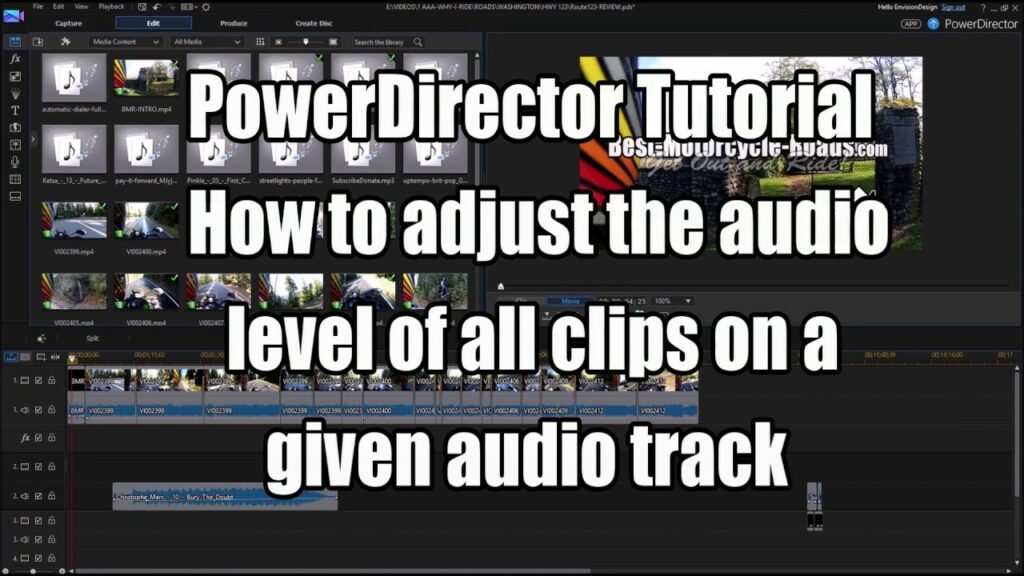How to adjust audio levels in PowerDirector

Adjusting audio levels in PowerDirector is a fundamental skill for any video editor. Properly balanced audio enhances the viewer’s experience by ensuring that dialogue is clear, music is appropriately loud, and sound effects are neither overpowering nor too subtle. This comprehensive guide will cover everything you need to know about adjusting audio levels in PowerDirector, including the basics of audio editing, detailed step-by-step instructions, advanced techniques, and troubleshooting tips.
Introduction
PowerDirector, developed by CyberLink, is a powerful and user-friendly video editing software that offers a wide range of audio editing tools. These tools allow you to adjust audio levels, balance different audio tracks, and apply various effects to enhance the overall sound quality of your video projects. This article will guide you through the process of adjusting audio levels in PowerDirector, ensuring your videos have professional-quality sound.
Understanding Audio Levels
Audio levels refer to the volume or loudness of an audio signal. Properly adjusting audio levels is crucial for creating a balanced and professional-sounding video. Key concepts to understand include:
- Decibels (dB): A unit of measurement for audio levels. Higher decibel values indicate louder sounds.
- Peak Levels: The highest points of an audio signal. Avoiding clipping (distortion) at peak levels is essential.
- RMS Levels: The average power of an audio signal. RMS levels provide a better indication of perceived loudness.
- Noise Floor: The level of background noise. Ensuring a low noise floor improves overall audio clarity.
Preparing Your Project
Importing Media
Before adjusting audio levels, ensure your media files are properly imported into PowerDirector.
- Open PowerDirector: Launch PowerDirector and create a new project or open an existing one.
- Import Media Files:
- Click on the “Import Media” button in the Media Room.
- Select the video and audio files you want to use and click “Open” to import them.
- Add Media to Timeline:
- Drag and drop your video and audio files from the Media Room to the timeline.
Organizing Audio Tracks
Organize your audio tracks to make the editing process smoother.
- Separate Audio Tracks:
- Place dialogue, music, and sound effects on separate audio tracks in the timeline.
- Label Tracks:
- Label each track for easy identification (e.g., Dialogue, Music, SFX).
Basic Audio Level Adjustment
Using the Audio Mixing Room
The Audio Mixing Room provides tools for adjusting the volume levels of individual tracks and the master volume.
- Open Audio Mixing Room:
- Click on the “Audio Mixing Room” (icon of a speaker) in the Media Content tab.
- Adjust Track Volume:
- Select the audio track you want to adjust.
- Use the volume slider to increase or decrease the track’s volume.
- Adjust Master Volume:
- Use the master volume slider to adjust the overall volume of your project.
Adjusting Audio Levels in the Timeline
You can also adjust audio levels directly in the timeline for more precise control.
- Select Audio Clip:
- Click on the audio clip in the timeline to select it.
- Adjust Volume:
- Hover your cursor over the horizontal line in the audio waveform.
- Click and drag the line up or down to adjust the volume level.
- Add Keyframes:
- Right-click on the audio clip and select “Add Keyframe.”
- Use keyframes to adjust volume levels at specific points within the clip.
Advanced Audio Level Adjustment Techniques
Using the Audio Editor
The Audio Editor offers advanced tools for fine-tuning your audio levels and applying various effects.
- Open Audio Editor:
- Right-click on the audio clip in the timeline.
- Select “Edit Audio” from the context menu to open the Audio Editor.
- Adjust Volume and Gain:
- Use the volume and gain controls to adjust the overall loudness of the audio clip.
- Apply Equalization (EQ):
- Use the EQ tool to adjust specific frequency ranges.
- Boost or cut frequencies to improve clarity and balance.
- Normalize Audio:
- Use the normalization feature to ensure consistent volume levels across all audio clips.
- Select “Normalize” from the Audio Editor options and choose your desired settings.
Audio Ducking
Audio ducking automatically lowers the volume of background music or sound effects when dialogue is present, ensuring the dialogue remains clear.
- Select Dialogue Track:
- Click on the dialogue track in the timeline to select it.
- Enable Audio Ducking:
- Open the Audio Mixing Room.
- Select the background music track and click on the “Audio Ducking” button.
- Adjust Ducking Settings:
- Set the sensitivity and attenuation levels to control how much the background music is lowered.
- Preview the effect and make adjustments as needed.
Using Keyframes for Dynamic Volume Changes
Keyframes allow you to create dynamic volume changes within an audio clip, such as gradual fades or sudden increases in volume.
- Add Keyframes:
- Right-click on the audio clip in the timeline and select “Add Keyframe.”
- Add keyframes at the points where you want the volume to change.
- Adjust Keyframe Levels:
- Drag the keyframes up or down to adjust the volume at each point.
- Create smooth transitions by adding multiple keyframes and adjusting their levels gradually.
Balancing Multiple Audio Tracks
Ensuring that multiple audio tracks are balanced is crucial for a professional-sounding mix.
- Solo and Mute Tracks:
- Use the solo and mute buttons in the Audio Mixing Room to isolate and listen to individual tracks.
- Adjust Track Levels:
- Adjust the volume levels of each track to ensure a balanced mix.
- Use keyframes to fine-tune the levels as needed.
- Check Peaks and Clipping:
- Monitor the peak levels of each track to avoid clipping.
- Adjust levels to ensure that no track exceeds 0 dB, which can cause distortion.
Tips for Effective Audio Level Adjustment
Monitor Audio Levels
Regularly monitor your audio levels using the VU meters in the Audio Mixing Room. Ensure that the levels are within the acceptable range and avoid clipping.
Use Reference Tracks
Use reference tracks with professionally mixed audio as a guide for adjusting your audio levels. Compare your project’s audio with the reference tracks to ensure consistent quality.
Apply Audio Effects Sparingly
While audio effects can enhance your sound, use them sparingly to avoid overwhelming the listener. Focus on achieving a clean and balanced mix before adding effects.
Listen on Different Devices
Test your audio mix on different devices, such as headphones, speakers, and mobile devices. This helps ensure that your audio sounds good across various playback systems.
Take Breaks
Take breaks during the editing process to prevent ear fatigue. Fresh ears can help you identify and correct issues more effectively.
Troubleshooting Common Audio Issues
Clipping and Distortion
Clipping and distortion occur when audio levels exceed the maximum limit, causing a harsh, unpleasant sound.
- Reduce Volume: Lower the volume of the affected track to prevent clipping.
- Use Limiter: Apply a limiter effect to cap the audio levels and prevent distortion.
Background Noise
Background noise can detract from the clarity and professionalism of your audio.
- Noise Reduction: Use the noise reduction tool in the Audio Editor to remove unwanted background noise.
- Record in a Quiet Environment: Ensure that your recordings are made in a quiet environment to minimize background noise.
Inconsistent Audio Levels
Inconsistent audio levels can make your video sound unprofessional and distract the viewer.
- Normalize Audio: Use the normalization feature to ensure consistent volume levels across all audio clips.
- Manual Adjustment: Manually adjust the volume levels of each clip to achieve a balanced mix.
Audio Sync Issues
Audio sync issues occur when the audio does not match the video, causing a disjointed viewing experience.
- Check Frame Rate: Ensure that the frame rate of your audio and video files match.
- Adjust Sync: Manually adjust the timing of the audio clip in the timeline to match the video.
Advanced Techniques for Professional Audio Mixing
Using Audio Effects
PowerDirector offers a variety of audio effects that can enhance your audio mix. Experiment with different effects to create unique sounds and improve audio quality.
- Open Audio Editor:
- Right-click on the audio clip in the timeline.
- Select “Edit Audio” to open the Audio Editor.
- Apply Effects:
- Use the available effects, such as reverb, echo, and equalization, to enhance your audio.
- Adjust the settings to achieve the desired sound.
Automating Volume Changes
Automation allows you to create dynamic changes in volume over time, adding interest and depth to your audio mix.
- Add Keyframes:
- Right-click on the audio clip in the timeline and select “Add Keyframe.”
- Add keyframes at the points where you want the volume to change.
- Adjust Keyframe Levels:
- Drag the keyframes up or down to adjust the volume at each point.
- Create smooth transitions by adding multiple keyframes and adjusting their levels gradually.
Creating Custom Audio Presets
If you frequently use specific audio settings, create custom presets to save time and ensure consistency across projects.
- Open Audio Editor:
- Right-click on the audio clip in the timeline.
- Select “Edit Audio” to open the Audio Editor.
- Save Preset:
- Adjust the audio settings as desired.
- Click on the “Save




